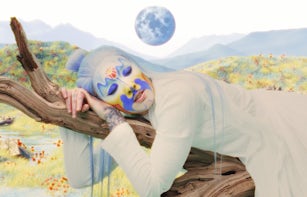
Shanghai, November 2000. Three young artists and friends, Yang Fudong, Xu Zhen and Yang Zhenzhong put together the exhibition ‘Useful Life’, featuring their own work, in a temporary space on Dong Daming Road, in the Hongkou district. Yang Fudong showed a fake photo-documentary about a brothel and a video installation with a complex arrangement of screens and monitors (prefiguring his signature multi-channel video installations). Xu Zhen organised a performance linked to video surveillance and showed photographs of naked men seen from behind with red paint between their legs, as if they were menstruating. Yang Zhenzhong showed a series of photographs of heads on pillows and, for the first time, his now famous work I Will Die (2000—05), a video wherein some forty people tell the camera ‘I will die’.
‘Useful Life’ took place as part of an almost feverish and insistent urge to organise experimental exhibitions at the end of the 1990s in China. It was no exception that the artists figured as their own curators: several of the most important exhibitions that took place at the turn of the millennium in the region had artists as their organisers, including ‘Post-Sense Sensibility: Distorted Bodies and Delusion’ (1999), curated by Wu Meichun and Qiu Zhijie, in the basement of the Yishequ Apartments in Beijing; ‘Art for Sale’ (1999), curated by Xu Zhen, Yang Zhenzhong and Fei Pingguo (whose Western name is Alexander Brandt), in a supermarket in Shanghai; and the infamous ‘Fuck Off’ (2000), curated by Feng Boyi and Ai Weiwei, at Eastlink Gallery in Shanghai. 01
Until the end of the 1990s there were hardly any appropriate spaces or opportunities for artists dealing with potentially sensitive subject matter or experimenting with new media or performance to display their work in mainland China. Though not all exhibitions that challenged the absolutes of mainstream ideological narration were closed down by the authorities, 02 they were all limited to small, privately owned or remotely located sites, such as academies and university campuses, or industrial spaces left vacant by developers (underground parking lots, office buildings, warehouses, bars and restaurants). Davide Quadrio remembers that ‘spaces were used as they were, art was put in the space to show it, without a real interaction between artwork-space and artwork-artwork’.03 Sometimes the exhibitions were only open for a few hours. Furthermore, information was only distributed among professionals in the field. Even when the exhibitions weren’t downright clandestine, the general public was hardly ever present.
In 1998 and 1999 major changes took place: the art scene was on the verge of a renaissance in subtle response to the politically repressive period of the late 1980s and early 90s and the dormant period in art that spanned the second half of the 1990s. 04 In this context, the characterisation ‘underground’ originated partly from the fact that experimental art could not be openly exhibited and partly from the fact that the international media regarded Chinese avant-garde art as the work of dissidents, thereby exaggerating the political and ideological significance of the avant-garde art of a socialist country. Artists, especially the younger generation, strategised to control the distribution of their artwork, increasingly aiming towards fame and international recognition.05
Before ‘Useful Life’, and after an early experimental group exhibition that took place in Shanghai in 1998, ‘Jinyuan Road no.130’, Xu Zhen and Yang Zhenzhong co-organised the aforementioned ‘Art for Sale’. The project took place on commercial grounds, open to the public, which the curators divided into an ‘installation space’ with artworks and a ‘supermarket space’ where the artists showed art objects that resembled merchandise, and was thematically linked to their works in the installation space. Even the catalogue, designed to look like a sales catalogue, contributed to the blurring of categories between art and consumer goods. 06 In an interview with Chen Xiaoyun, who besides taking part in ‘Useful Life’ wrote the essay for its catalogue, Yang Zhenzhong described the state of the Shanghai art scene before ‘Art for Sale’:
… many artists participated in exhibitions held in other places. Actually, Shanghai was not completely without exhibitions, Zhu Qi 7 had organised a few, but after each exhibition was over, things went pretty quiet again. It’s because the city itself is too commercialised. […] Back then many young people in Shanghai liked to make art but they had no opportunities. […] we often discussed these matters together, and we felt that ‘Art for Sale’ was a really good idea for an exhibition, totally in accordance with the city of Shanghai, which is like a huge market.07
Though it had to close three days after it opened, by mutual agreement of the curators and the supermarket owner, 08 the exhibition motivated Shanghainese artists to develop activities in their city, whereas previously Beijing had been the dominant centre of activity for contemporary Chinese art. The exhibition — as can be read in the somewhat ironic sponsor dossier drafted by the enthusiastic organisers in the almost naïve hope that they would find financial support from private companies 09— takes up a deliberately critical relation to the hyper-consumerism that had started to characterise Shanghai in those days. Social relations and everyday life, but also contemporary cultural practices, were affected by the influx of capital investment and an economy driven by commodity exchange. The exhibition made clear that there was ‘a need to make “art” as opposed to it being just another product’. 10Avant-garde culture could no longer define itself in relation to the state and resistance to or dissent from an authoritarian power. As Charles Merewether has observed, the challenge became to define avant-garde culture ‘in relation to an aesthetics of commodity culture and a latter-day form of the “society of the spectacle”’. 11
•
‘Useful Life’ was not an exhibition of an artist’s collective, and there were no collaborative works included. However, the exhibition might nonetheless have presented the viewer with a sense of collectivity, because some of the works were made within a shared mental space and all three artists worked in the media of photography and video. Yang Fudong, Xu Zhen and Yang Zhenzhong created the works especially for the exhibition, although they didn’t consult each other about the subject matter they were going to tackle. 12It was Yang Fudong, an artist who did not often venture into curatorial activities, who suggested that the project should include the three of them as the only participants. 13 This concentrated approach presented a strong contrast to exhibitions such as ‘Jinyuan Road no.130’, ‘Art for Sale’ or ‘Fuck Off’, which each comprised a huge number of artists’ works. Although all three of them later stated that it was a coincidence, or rather that it was ‘in the air’, 14 Yang Fudong, Xu Zhen and Yang Zhenzhong seemed to share an interest in the status of the human body that was becoming increasingly liberated from the extreme disciplinary power exercised over it in the latter years of Mao’s regime. Nevertheless, their work testified to a new generation of individuals who were discovering themselves twenty years after the Cultural Revolution within a newfound private sphere: a culture of consumers, excess and expenditure more than productivity and constraint. 15
Yang Zhenzhong showed the first part of his video work I Will Die during the exhibition. The individuals who face the camera and say ‘I will die’ are of different ages and speak in the maternal tongues of the different countries they come from. It has become the artist’s most famous work, and was shown in its longest version at the International Exhibition of the 52nd Venice Biennial in 2007, curated by Robert Storr. According to Yang, the power of the camera makes people stop thinking ‘— even if they are saying “I will die” — they basically stop thinking, and just perform. To the audience, these words produce a contradiction’. 16 The interplay between quick, repetitive editing — to create a succession of snapshots suggesting endlessness 17— and the existential weight of the sentence — which forces the speaker into an awkward self-representation (from giggling to adopting a gravitas in the enunciation) 18— gives this disturbing memento mori its poignancy. Each individual expresses the same truism. The tension between the different individuals and the unconceivable truth of death characterises this work with an unnerving, stringent logic. Jonathan Watkins has compared the people in the video to hostages ‘in some awful kidnapping scenario, […] living proof of their liveliness (they were there), foretelling their deaths’. 19 Besides this video, Yang also showed a series of black-and-white photographs of people’s heads upside down on pillows. Their expressions vary from laughter to distress, but it seems as if they all had been photographed in the midst of a nightmare. Upon closer inspection, we see that some faces are awkwardly mutilated, by means of digital manipulation: eyelids are sealed forever and some of the faces appear to have awakened after an ill-fated plastic surgery operation. The portraits suggest a space of friction and aesthetic and physical transgression.
During the exhibition Xu Zhen organised the performance I Am Changing Here (2000), which was directly transmitted to video. In a small space, five naked people were crammed into a large plastic bag. One held a video camera, and the footage was broadcast live as a projection in a big adjacent space open to the public. With this piece Xu created a situation that allowed bodies to explore their proximity to each other while forcing them to challenge the boundaries of socially permissible behaviour. Viewers witnessed a camera hovering over the body parts in real time, and such forced voyeurism intensified the uneasiness of the audience. In Xu’s series of photographs in the exhibition, The Problem of Colour (2000), the backsides of nude male bodies are shown in all their vulnerability. The poses of these men are unheroic, and recall depictions of juvenile male nudes in Western art. The idea of transgression is evoked by just a subtle drip of red paint running down from their buttocks, suggesting menstruation blood.

Although these photographs hint at homosexual practises or possibly sexual aggression, the artist considers them as a playful take on the politics of sexuality. For Xu they are by no means motivated by an emancipatory drive in relation to gender issues. 20Neither do they deal in lowness, wherein man is reduced to his backside, as the orifice for the passing of shameful waste.There is nothing abject in these pictures, but rather an insistence on beauty. The drips of red paint, paired to the idealised beauty of the ephebic male bodies, causes the viewer to do a double-take. In his text ‘The Long Striptease: Desiring Emancipation’ (2004), Merewether argues that in these works we don’t exactly find an ‘aesthetics of emancipation’. Rather, ‘we are witness to a radical disenchantment with the real’. He continues: ‘The subjects turn back, inward, in a perverse relation to the self and to notions of the real.’ 21 After years of being subjected to an extreme disciplinary power over their bodies, individuals were now subjected to forces involving the commodification of desire. The anaesthetised and amnesiac bodies weren’t affected by pain or pleasure in a way that could mobilise their power of agency and therefore transformative potential — a lack of response that shows the individual’s disaffectedness. 22 At the same time, the photographs remind us that we increasingly live in an image-reality in which by digital operations make all kind of images believable, and that we have reached the historical moment when media and the virtual shape our environment and interfere with reality.
The catalogue text for ‘Useful Life’ manifests a profound disillusion with the legacy of communism and identifies consumerism as a new battlefield.
Again, it could be argued that Yang Fudong’s contribution as a co-curator of ‘Useful Life’ made this exhibition quite different in tone from the other experimental exhibitions at the time. His answer to the replacement of a state-organised public sphere with state-induced consumption was withdrawal. Contrary to the often very energetic behaviour put forward by Yang Zhenzhong and Xu Zhen in their artistic as well as curatorial practices, Yang Fudong seems to prefer a life of the mind in a society of exacerbated materialism, ‘asserting the need for intellectual retreat in order to preserve idealism from corruption’. 23 In Yang Fudong’s Tonight Moon (2000), small monitors depict men swimming naked, while others feature expressionless men in suits, who amuse themselves by playing around in boats or by hiding behind trees in a garden. These small monitors are embedded in a large screen onto which an image of a garden is projected. Before this big screen there are two rows of monitors featuring other scenes that occur in the garden. Multiple spaces and times appear to exist simultaneously, and similarly the story lines divide. The scenes might be daydreams. Yang Fudong says that he chose to create this effect after noticing that the way people play in gardens gives free rein to their imagination and enables them to enter their own fantasy worlds.

An arched gateway in the traditional Chinese garden is meant to represent the border between the real world and the enchanted land beyond. 24 The scenes recall the literati paintings of ancient China, made by artists and intellectuals escaping the real world to pursue spiritual freedom by living in reclusion. 25 The literati became an obsessive topic in much of Yang Fudong’s subsequent work, as in his renowned film series Seven Intellectuals in a Bamboo Forest (2003—07), where, facing the suppression of political power in the past and the oppression of the present economic power, Chinese intellectuals are shown confronted with the paradox of positive participation in worldly affairs or standing aloof from them in negative abstinence. Yang’s series of photographs Shenjia Alley — Fairies (2000), also featured in ‘Useful Life’, brings the literati’s blank expressions and impassive attitude from the daydream to the brothel. Emptied of any suggestion of agency or of the immediacy of experience, the photographs portray naked or half-dressed young women passing time and possibly waiting for customers — suggesting a certain type of consumerism.
•
So what, then, is the importance of ‘Useful Life’? The catalogue text, a rather cynical and nihilistic pamphlet written by Chen Xiaoyun, gives insight into the pool of ideas and the mindset that motivated the exhibition itself. Titled ‘Reasons for a Daydreaming Proletariat’, the text manifests a profound disillusion with the legacy of communism. It identifies consumerism as a new battlefield and suggests escapism as an inevitable but ultimately unsatisfying strategy: ‘In the fleeting dreamland you might realise the integrality [sic] of the odious “Utopia”.’26 Moreover, the text is spread with apparent self-hatred, exhorting readers to ‘deprive yourself [of] ownership of your person and self-vaporise in a new dismembering sense and alternating loop. Come up with a little nerve and trample upon yourself to experience a first-class aesthetic enjoyment.’ 27
Merewether picked up on the corporeal nature of this response to consumerism, pointing out that ‘this generation [of artists] sought to discover through their bodies the experience of subjectivity and interiority, auto-affection and self-knowledge’. 28 That is also why, according to Hou Hanru, there is nothing heroic about the works made by young artists during this period, 29 and it is tempting to believe that ‘Useful Life’ was the only ‘experimental exhibition’ produced at the time that was somehow conscious of that fact. However critical of the old nationalistic or utopian discourses, the work of Yang Fudong, Yang Zhenzhong and Xu Zhen shows a certain joint awareness that the state’s realisation of the prescribed Chinese utopia had transformed, and that it was using subtler strategies than imposition by force.
The year 2000 was also that of the 3rd Shanghai Biennial, co-curated by Hou, Toshio Shimizu, Li Xu and Zhang Qing. It was the first time the official Chinese art world opened up to the rest of the world.30 But the importance of the 3rd Shanghai Biennial must be considered in the light of all these experimental exhibitions that became platforms for reforming the existing exhibition system and questioning the public function of experimental art. Both ‘Fuck Off’ and ‘Useful Life’ took place in the same period as the Shanghai Biennial, and to a certain extent they too were contextualised by the new openness. The three artists who organised ‘Useful Life’ also participated in ‘Fuck Off’, but they were not invited for the Biennial. While Ai Weiwei and Feng Boyi’s ‘Fuck Off’ was based on suspicion towards the new tolerance — thus reconnecting to the 1980s and the formation of a dissenting avant-garde 31
— ‘Useful Life’ seemed to embrace the new openness, being steered towards complex visualisation, and being less a tactical than a speculative exhibition. Critics compared the subtleness, sophistication and more playful, whimsical absurdity of ‘Useful Life’ to the shock-for-shock’s-sake, shut-us-down-so-we-can-be-famous-please sensationalism of ‘Fuck Off’. 32 The authorities indeed closed ‘Fuck Off’ immediately after the opening night, while surprisingly ‘Useful Life’ did not have to close its doors before its planned end date. The translation of both exhibitions’ titles opens up another interesting space of interpretation. ‘Fuck Off’ was the provocative English translation, deliberately targeting a Western audience, while the Chinese was ‘Bu Hezuo Fangshi’, which, as ‘uncooperative approach’, is more toned down.




